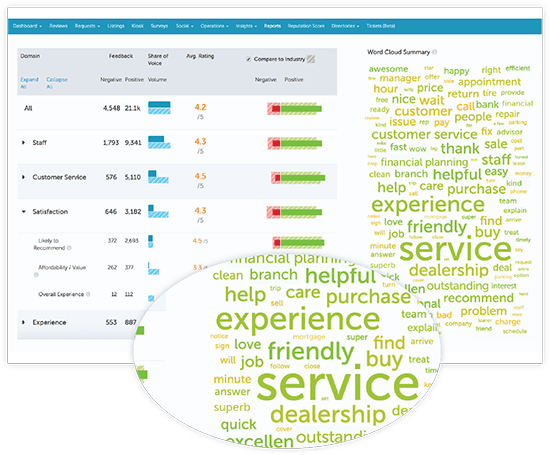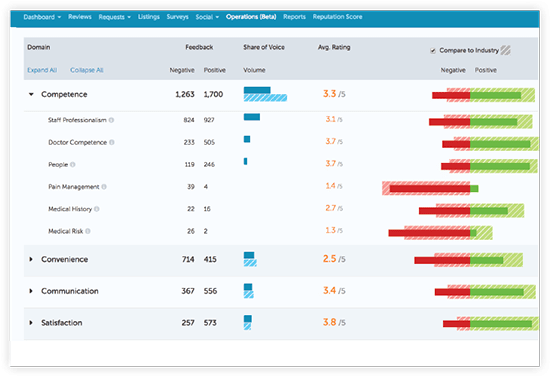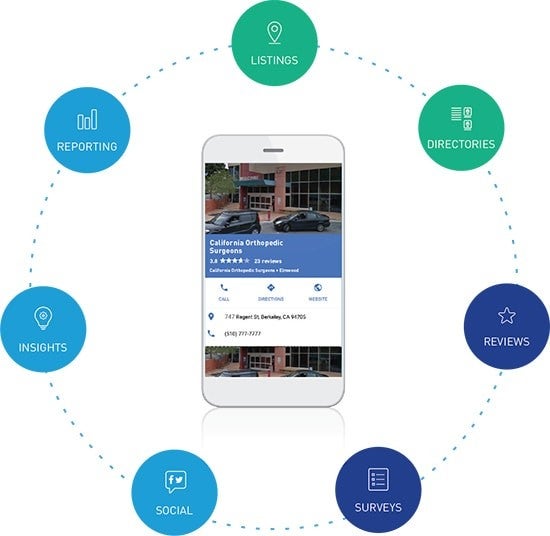ORM Guide: What is Online Reputation Management?
Reputation Staff Writer

And How To Set Up Your Own ORM Program
Your Online Reputation and Why It Matters
Whether your business is large or small — with one location or many — your customers are talking about you online. The impact of those online conversations cannot be underestimated. The viral nature of today’s information can create or destroy reputations in a micro-moment.
Your online reputation is a reflection of your overall brand and business health, and a leading indicator of future potential growth and success. That’s why Online Reputation Management (ORM) is so critical.
And the numbers prove it:
A recent Reputation.com analysis of businesses revealed that online-sourced sales for those implementing ORM programs grew 24% faster than for those not actively engaged in ORM activities.
What you will learn:
This guide provides you with the essential foundation in ORM so you can make it a reality within your organization. You’ll learn:
- What is Online Reputation Management?
- What are the three key components of ORM?
- How to launch an ORM program in your organization
Online Reputation Management, Explained
Buyers are self-directed, highly informed and comfortable making fast decisions based on online information. And one of the most valued sources of information is user-generated content — what others say about you in reviews and on social media, and how they rate you online. If prospects don’t like what they see, they’ll move on.
ORM enables businesses to leverage consumer-brand interaction data to drive improvements in reputation and customer experience.
The practice of ORM consists of three key functions:
- Organize your data
- Engage customers online
- Optimize the customer experience
Let’s take a look at each of these functions in greater detail.

Organize, Engage, Improve
1) Organize Your Data
Effective ORM entails creating a single source of truth for all of your company’s data, to ensure that your customers and prospects can find you online.
Claim and Audit Your Business Listings
With four out of five consumers using search engines such as Google to find businesses, accurate business listings are essential. Inaccurate listings erode trust and credibility, affect search results and ratings, and can deliver your customers right into the hands of your competitors. It’s absolutely critical that you audit, claim and correct all your online locations listings. Google My Business (GMB) is a good place to start, but your business may be listed on many other sites, as well. Implementing a process for auditing and correcting your listings helps ensure consistency and accuracy.
Enhance the Experience with a Finder/Locator Tool
A great way to help consumers find your locations is by incorporating fast website search capability. A Locator tool applies autocomplete and customizable filters against your categorically organized directory information, to drive site visitors to your locations and professionals according to their specific needs. A Locator tool can also provide referral management and appointment scheduling in one solution.
2) Engage Customers Online
ORM helps you engage customers proactively online, so the customer experience starts off on the right foot. A holistic approach to customer engagement has been shown to lead to more positive reviews, better star ratings and improved customer sentiment.
Request and Respond to Reviews.
Moz reported that reviews signals, such as the recency and number of your reviews, are one of the top-ranking factors in Google’s algorithm. And 69% of consumers say reviews older than three months don’t count. You can’t afford to wait for reviews to roll in — you have to ask for them. Make sure your strategy for review requesting includes mobile/SMS, as well as more traditional email and kiosks-based methods. Be sure to respond promptly — preferably within 48 hours of receiving a review — and acknowledge the input, whether positive or negative.
Engage Customers and Prospects with Social Media.
No business can avoid the influence of social media. Monitoring social channels and actively engaging with the community and influencers creates advocates, drives site traffic and gets the word out about positive reviews and feedback. Strategic, targeted social advertising can help raise brand awareness, as well.
Use Surveys to Identify and Address Issues.
Surveys help you collect information about how customers experience your products or services, identify what you’re doing right and uncover problem areas so you can fix them. Surveys should be brief, readily accessible and easy to complete via mobile apps, online forms or tablets.
3) Improve Customer Experience
Reviews and social media posts can alert you to recurring issues — such as long wait times or bad customer service at a specific location. You can use this information to make decisions about needed changes and prevent similar issues from happening in the future.
Data contained in the text of reviews and social comments is pure gold — but its unstructured nature makes it extremely difficult to analyze and act on. A capable ORM platform makes it easy to analyze feedback and data from reviews, surveys and social media in a single dashboard, to easily identify areas for operational improvements at the national and local level. Such operational insights can help you hone everything — from supply chain management to employee training.
Data analyzed – provides quick insights
A capable ORM platform makes it easy to analyze feedback and data from reviews, surveys and social media in a single dashboard.

Sentiment Analysis
With thematic analysis, words in online reviews are automatically grouped into categories, and the top keywords for each location are surfaced and displayed in a word cloud. The larger the word, the more often it has appeared in customer feedback. Words can be color-coded to indicate the sentiment (positive or negative) of the reviews in which those words appeared most frequently. Clicking on a word lets you drill down into the review text to understand context and route issues to appropriate parties within your organization.
Competitive Analysis
Advanced analysis tools can provide a more in-depth understanding of customer feedback and how you’re performing relative to competitors. The Reputation.com tornado chart reflects such an analysis and provides a benchmark for how a company is performing against competitive industry benchmarks.
Benchmark your performance
With access to these insights, you can continually refine customer experience, initiating a virtuous cycle that leads to more positive reviews and higher ratings, and a better overall reputation across all your locations.
Measuring the Results
Measurement and reporting are essential for demonstrating outcomes of your reputation management efforts. Your C-suite needs to see and understand important metrics about how the business is perceived online, how you rank against competitors, and how your locations rank amongst each other.
An ORM platform can pull data from all customer touchpoints into a single repository for detailed quantitative and qualitative analysis, and display results in a unified dashboard for easy consumption.
Reputation.com’s executive summary dashboard
This dashboard displays results for a variety of KPIs, such as average ranking, average rating, Reputation Score and review volume. Here you can see the business performance — overall and/or by location.
How to Launch an ORM Program in Your Organization
Businesses that implement an ORM program will have a huge advantage over those that leave their reputation to chance. The good news is ORM is a structured discipline that any organization can take on, step by step.
Secure Organizational Buy-In
A successful ORM initiative requires commitment from many departments in your organization:
- Executive Management: An executive advocate should be a wellrespected leader in your organization, who can articulate the importance of an ORM program and will serve as an advocate to company leadership and staff.
- Operations/Customer Service: Since operations leaders set the bar for customer experience, they stand to gain the most from the insights generated by ORM. They can use those insights to catalyze improvements that impact all customer interactions and help the business run better.
- Legal/Compliance: Be sure to involve legal and compliance teams in creating or reviewing templates for responding to reviews. This is especially critical for companies in industries that are heavily regulated, such as banking, financial services and healthcare.
Create ORM Goals Based on Your Current Online Reputation
Start by evaluating the current state of your online reputation. You may already have some components in place, and an assessment or audit of their effectiveness is critical to knowing what needs to be improved.
- For example, you may have a great star rating, but if it’s made up of just a few reviews, one of your ORM goals should be to build review volume.
- Or, perhaps your business listings are in need of an audit and update on major sites and directories.
- Maybe you need help with social listening and responding across multiple channels for all your locations.
Defining your short- and long-term goals will help you determine how to maximize your investment in your ORM strategy and the supporting technologies.
An ORM platform vendor can help you conduct the audits — or do it on your behalf — and provide an in-depth analysis of the current state of your online reputation. This exercise will help you decide where to focus your efforts.

TIP: Develop a Scoping Document
A scoping document ensure that you, your co-sponsors, the extended organization and your vendor have a common understanding of what will and will not be delivered at each phase.

Choose the Right ORM Provider
Not all ORM solutions are created equal. Use your scoping document to determine which platform best meets your business needs, and consider enlisting an ORM partner who can work with you to help you achieve your business goals.
Technical capabilities to consider include:
- Seamless integration that connects all the pieces of ORM (review sites, social media, business listings, surveys, etc.)
- Reliable, automated monitoring for multiple locations and sites across the web
- Intuitive, easy-to-understand dashboards that provide at-a-glance insights
- Powerful analysis and reporting tools
Next Steps
If you’re thinking about implementing an ORM program in your organization, arm yourself with best practices and some background on the technologies involved. Here are some useful resources to get you started:
